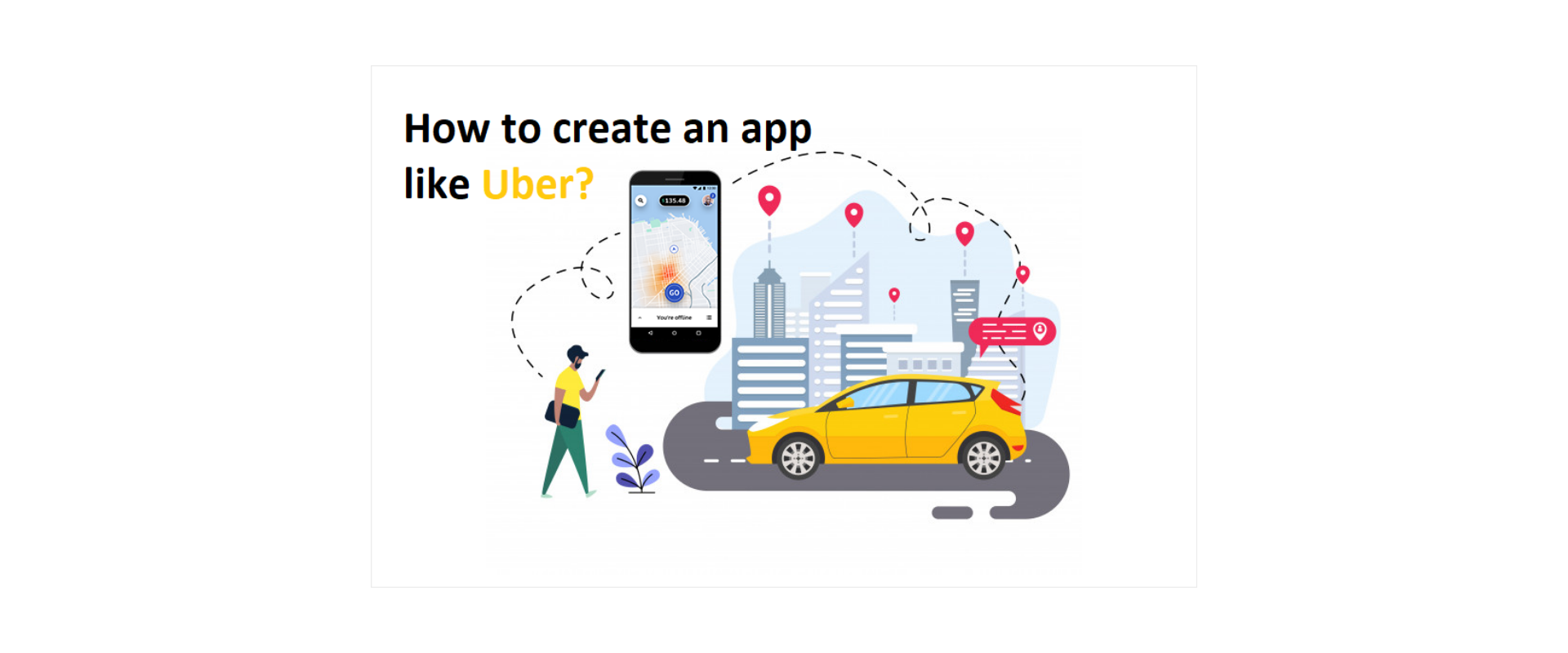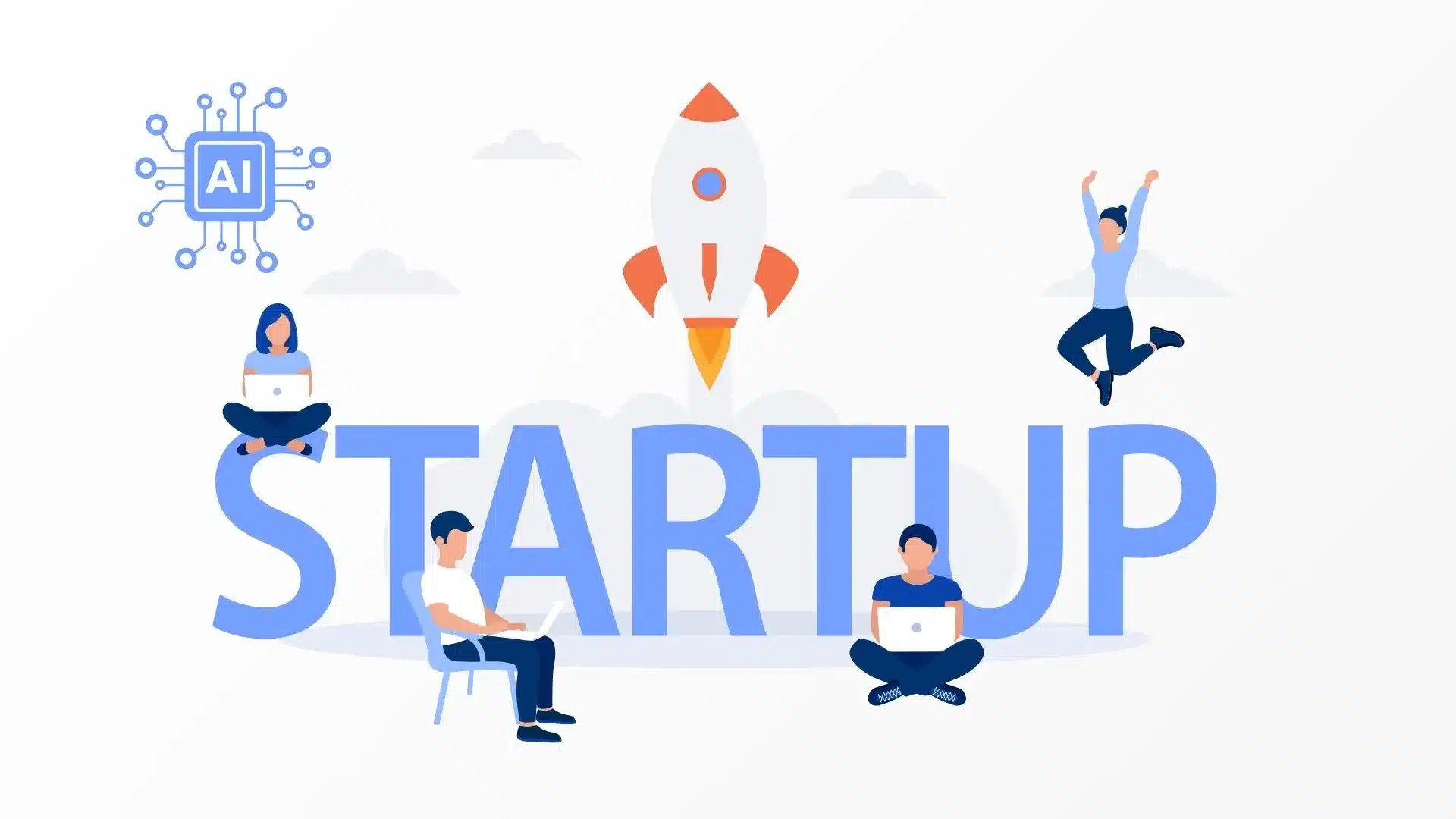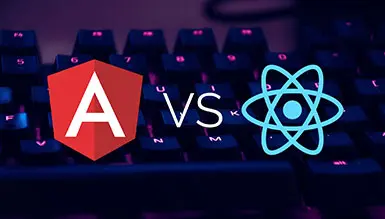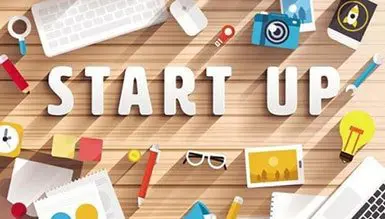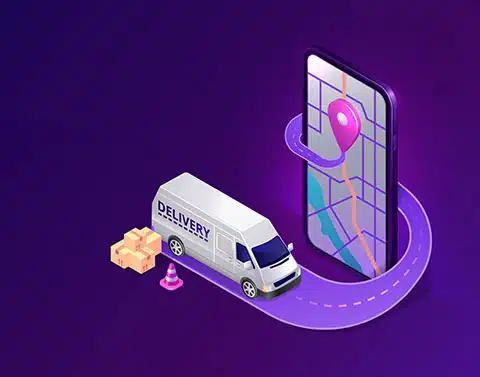A stranger picking you up from your doorstep would have been considered a bit dangerous about a decade ago. But life is much easier now that we have access to apps like Uber and Lyft on the tip of our fingers. How to create an app from scratch like Uber? In this article, we are going to discuss the same.
On-demand apps are on the rise. And today, apps like Uber have created a taxi-hailing lifestyle- something that we are so habituated to, we cannot live without it. Getting a taxi at your door as and when in need is a brilliant concept and a proven business model. But how do you create something unique and claim a stake in the market when various successful pick-up apps already exist out there?
The secret to Uber’s success among all other billion-dollar ideas is its simple, handy, and practical application. So, if you wish to compete with them, remember that your aim must not be to Create an app like Uber that matches all of its aspects- but to introduce ideas and features that Uber might lack.
With that said, let us take a look at Uber’s business model.
Understanding the Uber Market
Alright, let’s get right into it. To understand how to build an app like Uber, you first have to appreciate the operations of Uber. You first have to understand the uberisation of the on-demand taxi industry before you plan out a similar and effective solution.
Uber estimated a whopping $16 billion revenue by the beginning of 2019. As of now, it is available in 500 cities from 60 nations worldwide. It has now garnered about 50 million users from both- Android and iOS platforms and finished almost 10 million rides as you are reading this article.
What is it that makes the app so loved? Primarily, it’s free-to-use, easy to surf, bug-free, and yet minimal interface. Let us now take a look at the working of an Uber app.
How Does the Uber App Work?

An Uber driver receives direct trip requests through the Uber app. These people use their own vehicles to ferry the passengers from one location to another. The more requests they receive and the more distance they travel- the more they earn.
But here’s a catch- the app immediately looks for the available cars closest to the passenger’s location. Now, both the parties check their real-time location from the app itself and continue with the final booking.
Check out these 5 steps to understand the working of Uber:
Step 1: The customer mentions the pick-up and drop-off location on the app and creates a tip. They can choose from a range of vehicles, and they will be charged accordingly.
Step 2: The user verifies the tip by confirming the pickup location along with the other relevant data.
Step 3: The app finds the nearest Uber driver and sends them a request. The driver is free to cancel this request, and the request would be passed on to the next Uber driver available nearby.
Step 4: The user can pay from the available digital modes of payment that they might have added earlier. The Uber app supports debit cards, credit cards, PayPal, Apple Pay, Android Pay, and more.
Step 5: Uber also provides its audience with a rating system. They can associate the score of every rise and maintain a digital record of the different drivers who might have picked them. This step is very innovative. it helps the future passengers choose a driver accordingly.
Note: The fare calculation for Uber is very simple. It involves both- the distance covered and the time taken in a trip. For example, if a car moves at a speed slower than 16 mph, the passenger would be charged per minute. But if the speed is good, they will be charged based on the traveled distance.
Recreating the Functionalities- How to Make an App Like Uber?
To create an app like Uber, you have to ensure that you work on and maintain three separate panels- one for the drivers, one for the riders, and one for the admin. This admin panel would connect the rider and driver. Thus, developing the following three would be a prerequisite:
- The app for the drivers
- An app for the passengers/ riders
- An app for the admin panel for managing the business
Added to this, your service must have a landing page acting as the entry point for drivers as well as interested passengers where they would sign up.
Sounds overwhelming- we know. So, let us break it down into separate panels and the required features, shall we?
Features Required to Create an App like Uber
When you make an app like Uber, you basically connect the drivers to the passengers. So, you will need a lot of features for all three panels separately. Let’s take a look at a few examples, and you can brainstorm with a few more ideas later:
Customer Apps
The customer panel is only visible to the customers. It allows a viewer to request rides, and is thus, inclusive of various features like real-time updates about rides, real-time matching of passengers and riders, payment portals and various options for the same, verified profiles to ensure security, a list of available vehicles and fares, etc.

Here are some basic features that the customer app may have:
- Calling or texting the driver right from the app
- Geolocation and routing
- Ride states
- Payments
- Ride cost estimation
- Push notifications
- Personal profile
- Registration and personal data management
Check out some advanced features as well:
- Scheduling rides in advance
- Booking rides for others
- Splitting the ride fare with companions
Driver Apps
This panel would work for the driver’s end. They would use the driver app to share their current location, locate available customers for matching, and earn from their services. This app would, thus, require integration of features like real-time checking of requests, scheduling of requests, locating trip details, chatting with the customer or calling them for clarification, accepting or declining a request, tracking payments through tools, and many more.
Here are some basic features that may go into the development of a driver app:
- Route optimization
- Driver reporting
- ‘Active/ Inactive’ option to indicate availability
- Geolocation and routing
- Daily or monthly reports of bookings and earnings
- Ride states
- Calling or texting the passenger right from the app
- Push notifications
- Ride cost estimation
- Personal profile
- Registration and personal data management
Look at a few advanced features, in case you want your app to be more interactive:
- Sophisticated reporting
- Heatmaps (for example, for showing street traffic)
- Free cancellations within a set period of time
Admin Panel
This one is usually in the form of a web-based panel that the admin can access via the internet using any available browser.
The admin panel is very important, as it connects both the panels mentioned above. A user can customize it with features like analytics, regular reporting, passenger management, etc.
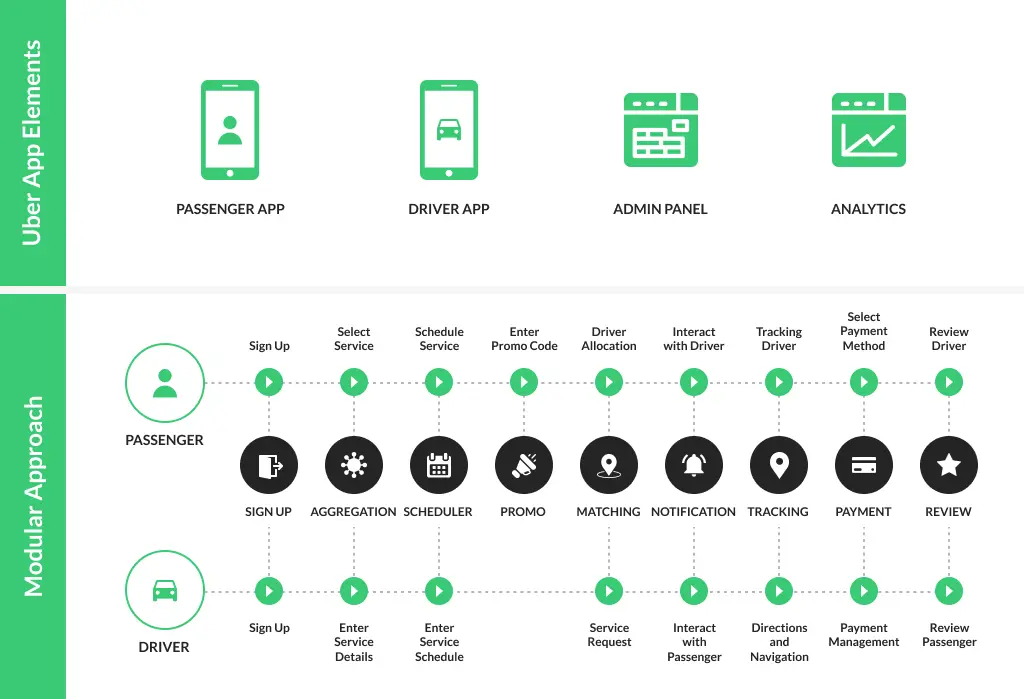
Here are some main functions that you can perform as a dashboard admin for an Uber-like app:
- Managing admins’ privileges
- Adding and deleting admins
- Changing the price of a ride
- Browsing the list of drivers
- Driver verification
- Updating drivers’ data
Technologies Used to Build an App Like Uber
How to build an app like Uber with the best features?
You need to take a sincere look at the technical aspect as well. The mobile application developers must have the technical prowess and knowledge to work on bringing such apps into a reality. Here are a few technicalities that you must consider:
Which Platform to work on- iOS or Android?

Make sure you choose one of these before getting started. If you wish to make an Android app like Uber- a native app, then it would be able to use more ingenious features of the Android devices. Native apps usually take less development time and are more interactive with their interface.
But if you wish to reach more audiences, try building a cross-platform application that works on Android as well as iOS. Confused with your decision? Contact our consultant at JumpGrowth. We will help you narrow down your requirements.
Geolocation
It is the primary technology that a majority of on-demand apps need these days- for grocery shopping, food delivery, home decor, carpooling, etc. Thus, these types of apps would require you to rely heavily on these technologies for mapping and navigation:
- The app should correctly identify the user’s location via their device with the help of the Core Location framework in the iOS devices and Google API locators in the users’ Android devices.
- Both the iOS and Android phones must have had maps in the form of Google Maps. It needs GPS and geolocation to locate its position on the app.
- You can go for map services from other mapping tools/ software other than Google.
- Drivers need accurate directions. Google Maps API helps them with the same on Android devices, while MapKit is useful for the iOS ones.
Push Notifications
Once you are aware of your users’ and drivers’ geolocation, the next effective integration would be push notifications and regular SMS. It works like this- when someone is present on your platform, they need regular updates about the current status of the ride. One cannot check the app, again and again, to communicate with their driver, especially when they are busy. Push notifications help them know that their ride was accepted, their driver is on the way, and then inform them when the driver reaches their doorstep.
Thus, you must use push notifications in your software to help drivers and passengers maintain communication without even using the app continuously. You can reduce your engineering efforts by using BaaS or Backend as a Service to develop effective options for push notifications.
SMS
SMS services are not something your app cannot live without- but they are very helpful. For instance, in some cases, the users may be facing internet issues and may fail in receiving regular notifications from the app. How do they know their ride’s status now that they can’t even refresh the app? SMS acts as a secondary mode of communication here. It is also helpful when the customer misses out on their push notification. Try using SMS services with your app, especially for OTPs, as they will act as proofs for booking, in case the transaction of payment fails.
Now that we have mentioned payment, let us look at the last (but not the least) thing that you must integrate.
Integration of Payment Options
This one is unavoidable. Try to adhere to certain policies when integrating multiple payment options through your app, as the data is sensitive. Try working with reliable transaction options and credible third parties. Never miss out on providing every popular payment option, as sometimes users may decide not to go with a booking just because the payment option, they usually opt for isn’t available.
Also, don’t skip on providing the passengers with a COD (cash on delivery) option.
Revenue Model of Uber-like App
The Uber app doesn’t own a fleet of cars. It rather earns its profits by hiring drivers who already own a vehicle- thus acting as a mediator between the passenger and the driver. For monetization, Uber charges a 25% fee on all the fares for using the software, collecting and transferring the fees, commissions of credit cards, and sending of invoices to the passengers.
But you can have a different monetization plan for carpooling or ride-sharing, such as:
- Creating a freemium version of the app, where the users won’t be charged for downloading or using the app but would be charged for the premium features.
- You can directly charge from the passengers and employee drivers accordingly.
- You can charge drivers for using your platform, and let them earn on their own. It’s like a mode of subscription.
- Charge cancellation fees whenever a rider or a driver cancels a ride. You may also provide a slot for cancellation during which no fees will be charged. If someone cancels the ride after the time slot is over, they have to pay the charges.
- Integration with other services and apps would also bring better traffic and help you earn via affiliation.
There are many ways in which you can make money from apps , but these alternatives would be most viable. Or you can simply follow Uber’s strategy as well (charging commission from drivers). It’s tried and tested!
How Much Does It Cost to Create an App like Uber?
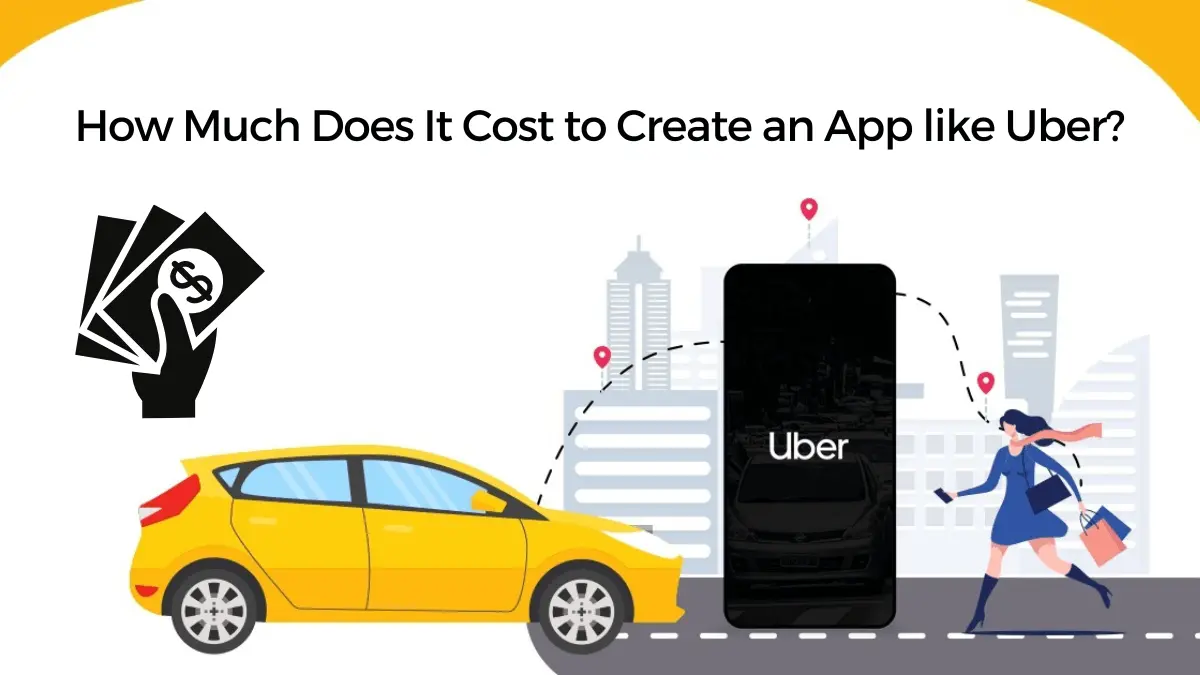
I want to make an app like Uber, but would it even fit my budget?
The answer to the question, “how much does it cost to create an app like Uber” depends upon the total time and resources that go into the process of development.
For instance, a simple app with a basic UI covering particular geolocation might cost you less. But if you are willing to launch an interactive app with multiple filter options for the type of vehicles, distance of commute, the preference of timing, scheduling of a trip, etc.- then you might have to invest more.
Added to this, you have to decide if you want to make an Android app like Uber, an iOS one, or for both. Then you have to integrate with third parties, especially Google maps and GPS, utilize the inbuilt features of devices, perform multiple tests on different network configurations, GPS signals, etc.
The average cost to make an app like Uber would range from $40000 to $200000 on development alone. Looking for cost-effective solutions? Contact JumpGrowth to cut your engineering hours and avail a pocket-friendly solution tailored to your needs.
What Factors Influence the Uber App Development Cost?
It is more complex than copying Uber’s model; there are several additional considerations to keep in mind. When we begin working with a new client, we usually try to understand where they stand on key subjects. We ask that our clients supply us with their company goals and the app’s overall concept, expected budget, conditions, and needs.
Let us look at the variables that can impact the expense of developing an app like Uber.
Features: The final cost to develop an app like Uber depends on the features you choose. The development cost will change based on how many standards and additional features you want to include in the app.
For instance, services like Uber and Lyft started with minimum viable products and are now expanding.
Your Company Type: The type of business is also a crucial consideration. Are you looking to start a cab business, or have you already run one? In the first scenario, you might benefit from a mobile app designed specifically for the way your company operates.
In contrast, launching a startup necessitates concurrently developing both the app and the business itself. This approach allows for more leeway but usually comes with a smaller budget.
The necessary financial outlay may vary depending on the variety chosen.
App Platform: Which Framework Should I Use? This is a perennial dilemma for business owners. But the solution is easy: develop for both Android and iOS if you want your app to reach the widest possible audience.
If you are working with a limited budget, which is common, you can choose between iOS and Android for your minimum viable product (MVP) development.
For instance, Uber’s initial release was only for iOS because, at the time, Apple’s mobile operating system held over 80% of the market share (in the US market).
Technology: In most circumstances, it is more logical to design a native app rather than a hybrid one. Architecture, programming language, and other factors all contribute to their distinctness.
Founders who are not computer savvy should seek advice from a mobile development service provider before settling on a specific strategy for creating an app like Uber.
How can I reduce the cost of making an app like Uber?

Creating an app like Uber and saving money by hiring a vendor from a favorable outsourcing zone is doable. App development costs between $70,000 and $120,000 if you hire a business like JumpGrowth, which charges an average of $30 per hour.
Time Taken To Make an App like Uber.
Just the cost incurred in development, the time that goes into development also depends directly on the features that you want to include in the app and the total time that goes into its development.
So, how long to build an app like Uber?
Here is a brief overview of the average time that goes into the development of the following features:
- Geolocation and routing: 150 – 200 hours
- Calling or texting the driver right from the app: 50 – 100 hours
- Ride states: 100 – 120 hours
- Ride cost estimation: 16 – 32 hours
- Payments: 105 – 175 hours of developers’ work
- Push notifications: 90 – 160 hours
- Registration and personal data management: 90 -150 hours
- Personal profile: 40 – 60 hours
- Driver reporting: 16-24 hours
- Route optimization: 24-60 hours
- “Active/ Inactive” option: 30 – 50 hours
- Daily or monthly reports of bookings and earnings: 70- 110 hours
- Calling or texting the driver right from the app: 50 – 100 hours
Added to this would be the admin panel and backend development. It would typically take about 2,500- 3,500 hours to develop the backend and 350- 500 hours to work on the admin panel. So, all in all, the level of intuitiveness and interaction of your app dictates the total time that goes into its development, but it would roughly take 5-7 months to create an app from scratch.
Things to Know About Uber-Like App Development
It is important to emphasize how large Uber is before we go any further with the discussion. Uber’s monthly global user base reached 93 million at the end of the fourth quarter of 2020. In comparison to the previous quarter’s reports, this is a whopping 19-fold increase. Lyft is another major player in the ridesharing market, alongside Uber. When compared to Uber, which by 2020 had captured 70% of the market, Lift was only able to muster 30%.
With its streamlined app-user interaction, successful marketing efforts, and low mistake reports rate, Uber has cornered a sizable portion of the industry. As of this writing, the Uber Android and iOS apps connect riders with drivers around the clock, every day of the year in more than 800 locations across 84 countries. There is no longer any need for either party to worry about when the automobile will arrive because they are both aware of each other’s whereabouts.
Our Final Thoughts
Although the taxi/ cab booking behemoths like Uber are pacing the industry and continue aggressively over their global expansion- there is always room for new players to compete and grow. After all, every app has sprouted out of an idea, and growth takes time. But it’s never impossible. But how to build an app like Uber?
We will tell you a secret.
Building an app is easier now more than ever!
Why waste your time in understanding the market and gaining expertise in development? JumpGrowth is here to the rescue. We build future-ready, scalable apps for our clients that rock the market every time. Contact us to discuss your developmental needs, and our representative will get back to you in no time.
Our experts can help you in Create an app like uber.
Frequently Asked Questions:
Q1: How does uber work?
- Uber forms a partnership with drivers.
- Whenever you, as a consumer, request a taxi on Uber’s App, the information reaches the nearest driver who will come to you.
- You will use the service and make payments via Paytm or any other application. You will not pay anything to the driver.
- Uber takes 20% of the fare, and the remaining 80% is split between the driver and the car owner according to the parameters previously agreed upon by both parties.
Q2: How to develop an app like uber?
The moment has come for taxi services that are currently only available offline to have an internet presence. However, to start an online ride-hailing business, you need to launch a mobile app for drivers, riders, and a web admin panel for managing operations.
Launching a taxi-hailing smartphone app requires either programming expertise or the resources to engage a development team and start from scratch.
Q3: How much does it cost to create an app like Uber?
The cost of creating an app like Uber often ranges from $100,000 to $150,000. Such apps have a trifold structure consisting of drivers, clients, and admins and are inherently complex due to the abundance of back-end procedures they require.
Q4: What are the main parts of apps like Uber?
There are three main components to taxi apps like Uber:
- an app for drivers
- a client app
- an admin dashboard.
Developing an app necessitates building all three of these applications.
